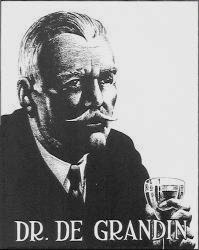
 Weird Circle (1943-45) aired “The Werewolf” (aka “The White Wolf and the Hartz Mountains”), as best as can be determined, in possibly the third week of June, 1944. It aired two 39-episode seasons, totaling 78 shows, with the first show airing on July 8, 1943. “The Werewolf” is listed as the 37th episode which would mark it as possibly airing in late June of 1944, near the end of the first season. Actually, however, “The Werewolf” was the 37th originally transcribed (created) episode as the complete surviving script log shows, but as the shows were syndicated they were run in any order the various station manager’s across the country (and in Canada) desired. My usual reliable OTR sources have not been able to fix a definite air date for any of the complete run of 78 shows, all of which have survived in overall relatively good shape.
Weird Circle (1943-45) aired “The Werewolf” (aka “The White Wolf and the Hartz Mountains”), as best as can be determined, in possibly the third week of June, 1944. It aired two 39-episode seasons, totaling 78 shows, with the first show airing on July 8, 1943. “The Werewolf” is listed as the 37th episode which would mark it as possibly airing in late June of 1944, near the end of the first season. Actually, however, “The Werewolf” was the 37th originally transcribed (created) episode as the complete surviving script log shows, but as the shows were syndicated they were run in any order the various station manager’s across the country (and in Canada) desired. My usual reliable OTR sources have not been able to fix a definite air date for any of the complete run of 78 shows, all of which have survived in overall relatively good shape.
“The Werewolf” harks back to more of an “Old World” style and atmosphere werewolf tale, as it takes place in the heavily forested, dark and forbidding mountain country of Europe, far from the bustle and commerce of humanity. A husband and father works for a noble of great importance. Unfortunately, following the desertion of his wife for unknown reasons, he has given the baron reason to avenge his attempted assassination with a death sentence (listen closely to find out the transgression), so he takes his family and escapes to the Hartz Mountains, where more misfortune befalls him, leaving only his three children to fend for themselves. When the children, bedraggled and wandering alone, come to a cottage and are taken in by a kindly man, and then are visited by a man and his beautiful daughter their troubles would seem to have come to an end. But this is where strange things begin to happen, things for which they are ill-prepared to deal. “The Werewolf” is darker than you may think, for not all stories have a happy ending.
[EDITOR’S NOTE: Regular listeners to these Saturday evening Old Time Radio shows should be aware that because next Friday, October 31st is Halloween, I will be posting next Friday rather than Saturday, and a few hours earlier than the usual 5 PM Central, U.S. time.]
Play Time: 29:04
{Kids like a good shiver. Ready for more after listening to “The Werewolf,” it wouldn’t take long for them to make it to the corner drugstore on a sunny Saturday afternoon in June of 1944 to feed their horror fix from any number of magazines.}
{Left: Doc Savage for June 1944 – Center: Planet Stories for Summer 1944 – Right: Weird Tales for July of 1944. It would seem that youngsters certainly wouldn’t need to wait until Halloween for their monster fix, for here they found stories of ghosts, terrors from outer space (with stories from both Leigh Brackett and Ray Bradbury in one issue!), and occult detective Jules de Grandin who fought werewolves, ghosts, and other supernatural, depraved entities.}



{The Seabury Quinn (1889-1969) Dr. Jules de Grandin story in the above issue of Weird Tales brought to mind an interesting story concerning two famous genre artists: Virgil Finlay (1914-1971) and Stephen Fabian (1930- ). The de Grandin character was created especially for WT, and over time and because of the popularity of the character there were 93 de Grandin stories and one novel published. De Grandin was usually accompanied on his adventures by his medical friend Dr. Trowbridge. Sixteen of the WT stories featured interior illustrations by Finlay, among them the portraits of de Grandin and Trowbridge. However, when Popular Library wanted to publish a number of de Grandin paperbacks in 1975 the original Finlay illustrations could not be found. Stephen Fabian was then asked to recreate original portraits based on the original published versions by Finlay. The Finlay depiction of the fictional de Grandin (below left) saw print in the October 1937 issue of WT. Below right is the Fabian recreation, which you can see is virtually identical, though Fabian did not employ Finlay’s painstaking and time-consuming stipple technique, for which he was known. Hats off to a pair of SF and Fantasy’s greatest artists.}

